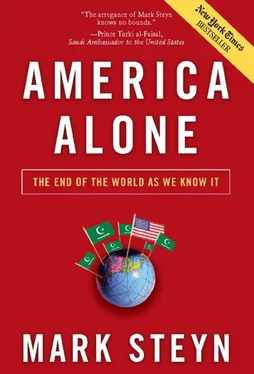My interest in demography dates back to September 11, 2001, when a demographic group I hadn’t given much thought to managed to get my attention. I don’t mean the, ah, unfortunate business with the planes and buildings and so forth, but the open cheering of the attacks by their coreligionists in Montreal, Yorkshire, Copenhagen, and elsewhere. How many of us knew there were quickly growing and culturally confident Muslim populations in Scandinavia?
Demography doesn’t explain everything, but it accounts for a good 90 percent — including the easy stuff, like why Jacques Chirac wasn’t amenable to Colin Powell’s schmoozing on Iraq: if the population of your cities was 30 percent Muslim, with spectacularly high youth unemployment rates and a bunch of other grievances, would you be so eager to send your troops into an Arab country fighting alongside the Great Satan? Stick a pin almost anywhere in the map, near or far: the “who” is the best indicator of the what-where-when-why. Remember how it was when you watched TV in the eighties? You’d be bombarded with commercials warning that the Yellow Peril was annexing America and pretty soon they’d be speaking japanese down at the shopping mall. It didn’t happen and it’s never going to happen. In the nineties, I tended to accept the experts’ line that Japan’s rising sun had gone into eclipse because its economy was riddled with protectionism, cronyism, and inefficient special-interest groups. But so what? You could have said the same in the sixties and seventies, when the joint was jumping. The only real structural difference between Japan then and Japan now is that the Yellow Peril got a lot wrinklier. What happened in the 1990s was what Yamada Masahiro of Tokyo’s Gakugei University calls the first “low birth-rate recession.” It’s not the economy, stupid. It’s the stupidity, economists — the stupidity of thinking you can ignore demography. Japanese society aged, and aged societies, by their nature, are more cautious and less dynamic: old people weigh exposure to risk more than potential for gain.
Another example: will China be the hyperpower of the twenty-first century? Answer: no. Its population will get old before it’s got rich.
Another: why did Bosnia collapse into the worst slaughter in Europe since World War Two? In the thirty years before the meltdown, Bosnian Serbs had declined from 43 percent to 31 percent of the population, while Bosnian Muslims had increased from 26 percent to 44 percent. In a democratic age, you can’t buck demography — except through civil war. The Serbs figured that out — as other Continentals will in the years ahead: if you can’t outbreed the enemy, cull ’em. The problem Europe faces is that Bosnia’s demographic profile is now the model for the entire continent.
The literal facts of life are also what underpinned the so-called “cartoon jihad” of early 2006. It was a small portent of the future: the publication by one Danish newspaper of various cartoonists’ mostly very mild representations of the Prophet Mohammed was the pretext for weeks of protests, lawsuits, death threats, rioting, torching, razing, and killing by disaffected Muslims from Calgary to Islamabad, London to Jakarta. On September 10, 2001, not many of us thought it would soon seem perfectly routine to hear news announcers read headlines like: “The Danish cartoon death toll is now up to nine.” No laughing matter, especially as that number multiplied into double and triple figures. But it’s remarkable how quickly we’ve internalized the underlying demographic reality. Like all the mini-crises afflicting the Continent since September 11, its subtext derives from the belated realization among Europeans that they’re elderly and fading and that their Muslim populations are young and surging, and in all these clashes the latter are putting down markers for the way things will be the day after tomorrow, like the new owners who have the kitchen remodeled before moving in. When it came to those cartoons, every Internet blogger was eager to take a stand on principle alongside plucky little Denmark. But there’s only five million of them. Whereas there are twenty million Muslims in Europe — officially. That’s the equivalent of the Danes plus the Irish plus the Belgians plus the Estonians. You do the math.
What’s the Muslim population of Rotterdam? Forty percent. What’s the most popular baby boy’s name in Belgium? Mohammed. In Amsterdam? Mohammed. In Malmo, Sweden? Mohammed. By 2005, it was the fifth most popular baby boy’s name in the United Kingdom. Yet most Europeans weren’t even aware of the dominant demographic trend until September 11, and subsequent events in Madrid, Paris, and London.
Or to put it at its most basic: Why is the world we live in the way it is? Why is this book written in the language of a tiny island off the coast of northern Europe? Why is English the language of global business, of the Internet, of the paramount power of the age and of dozens of other countries from Belize to Botswana, Nigeria to Nauru? Why does Canada share its queen with Papua New Guinea? Why does a quarter of the world’s population belong to the British Commonwealth and enjoy to one degree or another English Common Law and Westminster parliamentary traditions?
Because in the early nineteenth century the first nation to conquer infant mortality was England. Hitherto, the British Isles had been like the rest of the world: you had a big bunch of kids and a lot of them died before they could be of economic benefit to you or to society. But by 1820 medical progress and improvements in basic hygiene had so transformed British life that half the population was under the age of fifteen.
In sheer numbers, the country was still a pipsqueak cluster of North Atlantic islands with 28 million people compared to China’s 320 million. But it was the underlying demographic trend that proved decisive in the century ahead. Britain had the surplus manpower not just to settle Canada, Australia, and New Zealand, but also to provide the administrative and business class in the West Indies, Africa, India, and the Pacific. And, fortunately for the world, this demographic transformation occurred in a culture that even then had a longestablished system of law, property rights, and personal freedom. Imagine what the planet would look like if the first country to conquer infant mortality had been a country with a less sustained tradition of individual liberty — China, say, or Japan or Russia or Germany. The “what,” “where,” and “when” are important, but the “who” is critical. It’s hard to have a big influence in the world when there’s just a few of you and you’re all getting on in years.
So who’s in the situation of England at the beginning of the nineteenth century? What country today has half its population under the age of fifteen?
Spain and Germany have 14 percent, the United Kingdom 18 percent, the United States 21 percent — and Saudi Arabia has 39 percent, Pakistan 40 percent, and Yemen 47 percent. Little Yemen, like little Britain two hundred years ago, will send its surplus youth around the world — one way or another. Cultural relativists who sneer at the idea of English civilization should try to imagine what the world would be like if the U.S. Supreme Court and the Indian parliament and the Australian legal system, not to mention Harvard and Yale, Oxford and Cambridge, had been built on Yemeni values.
The state of our civilization manifests itself both in the non-problems that terrify us beyond all reason — rising sea levels — and in the real problems we pay no heed to. So David Remnick, editor of the famously factchecked-to-death New Yorker, declares to the magazine’s readers that the earth will “likely be an uninhabitable planet.” In reality, much of the planet will be uninhabited long before it’s uninhabitable. Yet environmentalists couldn’t be less interested in the politics of people — people who need people. Pace Barbra Streisand, they’re the unluckiest people in the world as we’re about to find out. When my second child was born, a neighbor said, “Well, you’ve got two. You can stop now.” She was being enlightened and responsible. After all, for her entire adult life, the progressiveminded have worried about “overpopulation.” And this view became so pervasive that, in an age of hysteria about “dwindling resources,” it became entirely normal to look on our greatest resource — us — as a liability. So today we’re the dwindling resource, not the oil. We’re the endangered species, not the spotted owl. The “population explosion” is a prop of the Western progressive’s bizarre death-cultism. We are so bad, so polluting, so exploitative, so violent, so destructive that we owe it to the world not to be born in the first place. As Dr. Sue Blackmore wrote (in Britain’s Guardian ) in an unintentional side-splitter of an envirodoom column:
Читать дальше












